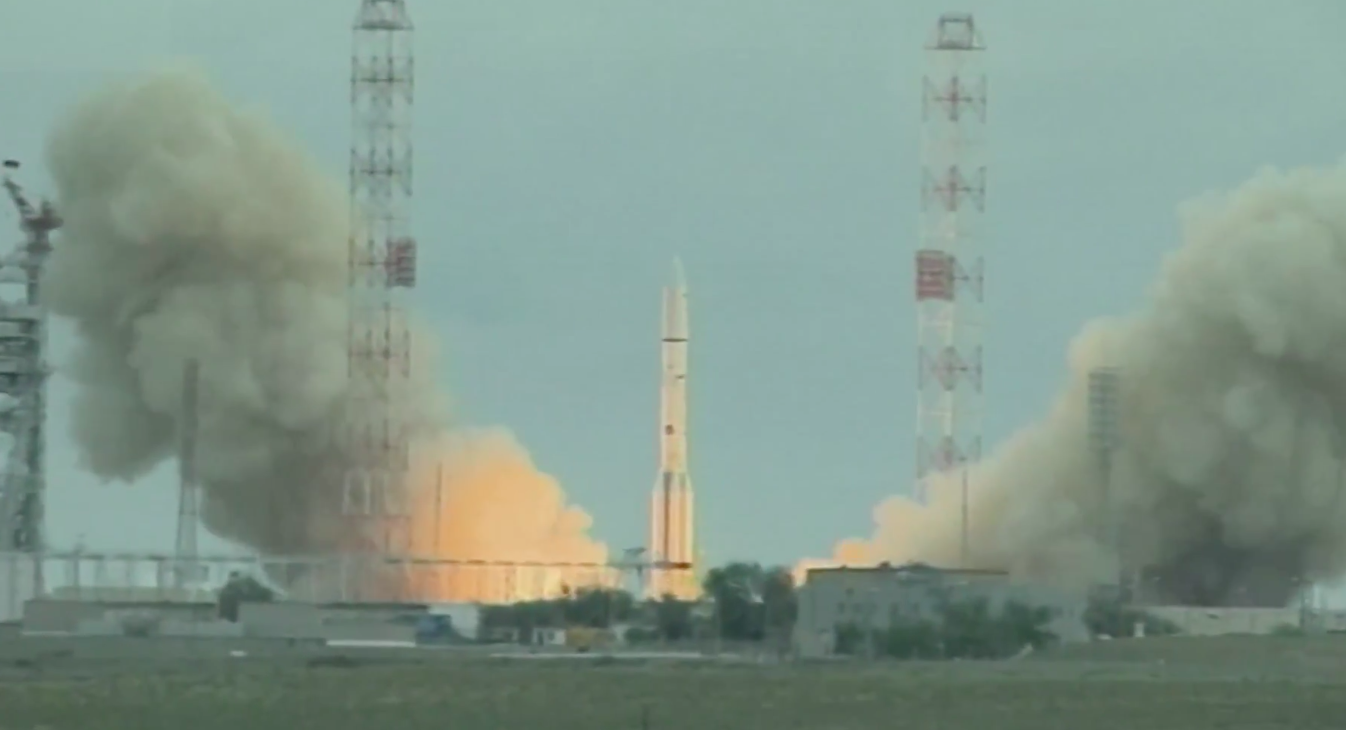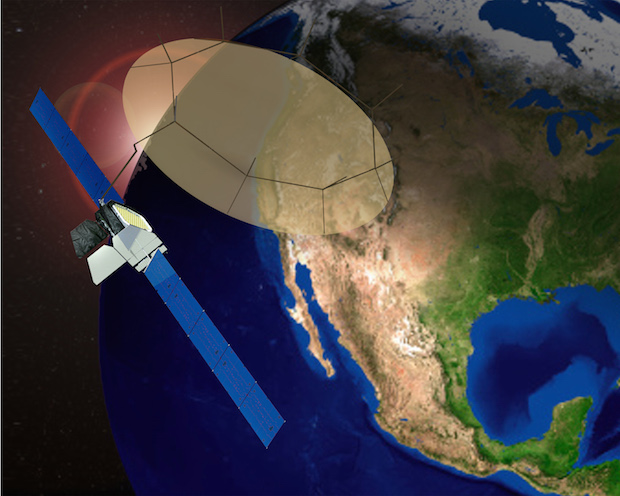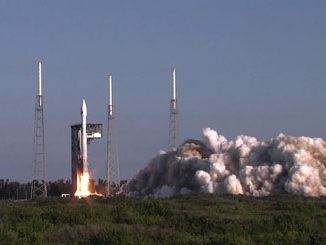
Failure struck Russia’s troubled space program for the second time in three weeks Saturday, when a Proton rocket carrying a high-tech satellite for Mexico’s new $1.6 billion space-based communications network crashed shortly after liftoff.
The 191-foot-tall Proton rocket launched at 0547:39 GMT (1:47:39 a.m. EDT; 11:47:39 a.m. local time) from the Baikonur Cosmodrome in Kazakhstan, smoothly climbed through low clouds and disappeared from the view of cameras at the arid Central Asia spaceport.
The first phase of the launch appeared to proceed according to plan, but something went wrong less than 10 minutes after liftoff.
A statement issued by Roscosmos — the Russian space agency — said an “emergency situation” occurred during the launch, but the press release provided no further details.
Russian news reports said the Proton rocket’s third stage failed about eight-and-a-half minutes after liftoff, just before the booster was programmed to disconnect from a Breeze M upper stage designed to guide the Mexican government’s Mexsat 1 satellite into an orbit stretching more than 22,000 miles above Earth.
The state-owned Tass news agency reported the preliminary cause of the accident was in the steering engine on the Proton’s third stage. A Russian space industry source quoted by Tass said the rocket likely fell back to the ground from an altitude of 160 kilometers — about 100 miles — and burned up in the atmosphere.
Any debris that survived the high-speed descent probably fell in a region near Chita, a city in Siberia near Russia’s southern border with Mongolia and China, according to Tass.
Space officials informed Russia’s Ministry of Emergency Situations of the crash site, Tass reported.
The Proton rocket’s third stage is powered by a single RD-0213 main engine producing 131,000 pounds of thrust. A four-nozzle “vernier” engine on the third stage is designed to steer the rocket on the correct path into space.
The rocket’s guidance, navigation and control system is a triple-redundant digital avionics package on the third stage.
International Launch Services, a Virginia-based firm overseeing Saturday’s commercial launch, confirmed the failure in a statement a few hours after liftoff.
“Preliminary flight information indicates that the anomaly occurred during the operation of the third stage, approximately 490 seconds after liftoff,” ILS said.
There were indications of trouble during a webcast of the launch, when an ILS program director providing commentary on the flight was unable to confirm the completion of critical engine burns, blaming a disruption in the flow of telemetry data from the rocket. The ILS manager claimed tracking information showed the launch proceeding normally.

ILS is owned by Khrunichev State Research and Production Space Center, the builder of the Proton rocket and Breeze M upper stage. The company is responsible for sales of Proton launch services on the commercial market.
The launch mishap dealt another major blow to Russia’s space sector, happening as engineers were still determining what doomed a Progress supply ship lost minutes after an April 28 launch with food, spare parts and experiments for the International Space Station.
A different Progress freighter had to abort a planned reboost of the space station’s orbit Saturday, Roscosmos said.
Saturday’s rocket crash occurred one year to the day after the last Proton launch failure, which destroyed a Russian communications satellite after an anomaly in the booster’s third stage propulsion system.
An investigation into the May 2014 launch failure concluded the “probable cause of the failure was the loss of structural integrity of a bolted interface that attaches the (third stage) steering engine turbopump to the main engine structural frame,” ILS said in a statement released in September.
Officials did not disclose how engineers planned to resolve the structural problem on future launches, but the ILS press release said in September that the “corrective action plan will adequately address the identified probable cause and contributors to the failure.”
The Proton rocket flew successfully six times since the May 2014 mishap.
According to Tass, same type of third stage steering engine is the early focus of the investigation into Saturday’s mission, which was the sixth failure of a Proton rocket or its Breeze M upper stage in 43 flights since December 2010.
Two other Proton/Breeze M missions in that period put their payloads into off-target orbits, but the satellites were able to recover from the shortfalls and continue their missions.
Commercial missions under the management of ILS amassed a mostly successful string of launches during the patch of Proton/Breeze M failures. ILS officials credited the company’s mission assurance services for the disparity in the Proton’s success record on commercial and government flights.
An ILS mission placed the Russian Yamal 402 communications satellite in the wrong orbit in 2012, but the spacecraft had enough on-board fuel to salvage its primary mission.
A malfunction in the Breeze M upper stage on an ILS mission in 2008 left the AMC 14 commercial telecom platform off its target. The satellite’s owner declared the satellite a total loss and collected an insurance payment, then insurers sold the spacecraft to the U.S. Defense Department, which maneuvered the satellite into a usable orbit.
Before Saturday, the last Proton failure that destroyed a payload under the auspices of ILS came in 2007.
“ILS remains committed to providing reliable, timely launch services for all its customers,” the company said in a statement after the failure. “To this end, ILS will work diligently with its partner Khrunichev to return Proton to flight as soon as possible.”
Once a leader in the rocket business, ILS has seen its share of the commercial launch market erode in recent years. The company announced its last firm contract win in January 2014, and commercial satellite owners since then have awarded the bulk of launch service deals to Arianespace and SpaceX.

The Mexsat 1 satellite lost Saturday was supposed to help establish a mobile communications network to link Mexican security forces, civilian authorities and remote outposts with 3G+ cellular voice and data services.
Built by Boeing in El Segundo, California, the 5.8-ton satellite — also dubbed Centenario in honor of the 100th anniversary of the Mexican Revolution — was designed for a 15-year mission for Mexico’s Ministry of Communications and Transportation.
The Mexican government signed a $1 billion contract with Boeing in December 2010 for three satellites, two ground stations and operations training. Mexico’s subsequent purchase of launch services put the Mexsat program’s total cost near $1.6 billion.
The first of the three Mexsat relay stations — named Mexsat 3 or Bicentenario — launched on an Ariane 5 rocket in December 2012. Orbital ATK manufactured the satellite as a subcontractor to Boeing.
The last of the satellite trio — Morelos 3 — is nearly identical to the craft launched Saturday. It is scheduled to launch as soon as October aboard an Atlas 5 rocket from Cape Canaveral.
Officials said Mexican troops, emergency responders, rural educators and hospitals will use the Mexsat satellites for national security and humanitarian applications.
The next Proton launch was supposed to deploy a powerful communications satellite for London-based Inmarsat in June, but Russian news reports said the rocket will be grounded while experts analyze the cause of Saturday’s failure.
Email the author.
Follow Stephen Clark on Twitter: @StephenClark1.



